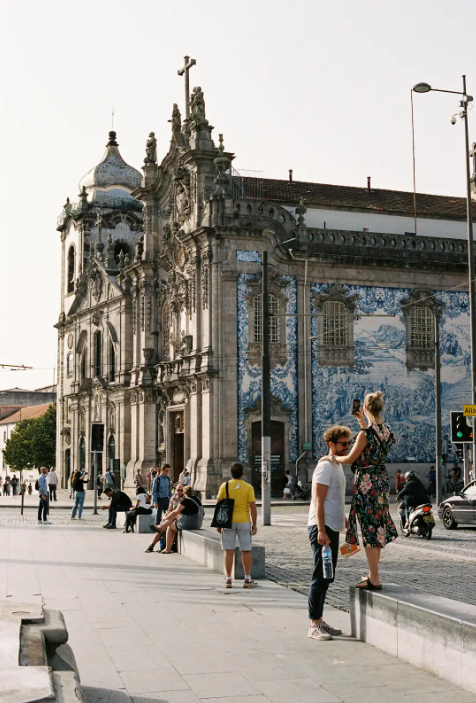
Antonio Obá’s art invites you to pause, reflect, and confront. It’s a visceral investigation into the layers of Brazilian identity, one that navigates the nation's tangled legacy of colonialism, racial discord, and cultural plurality. Through his multidisciplinary approach, Obá transforms both his personal experiences and collective memory into deeply poignant artistic statements. From using his own body as a medium to drawing on religious symbolism, Obá's practice challenges established narratives about race, identity, and history in contemporary Brazil.
Antonio Obá frequently makes his own body central to his art, a choice that is as courageous as it is purposeful. For Obá, identity is not an abstract intellectual exercise or a distant academic topic. It is lived, experienced, and embodied.
Consider his performance piece, “Atos da Transfiguração” (Acts of Transfiguration), where Obá covers his naked body in powdered spices, then ritualistically whisks them away with the Brazilian flag. This action bridges personal and collective narratives, confronting Brazil's deep ties to colonial exploitation and the erasure of indigenous and African contributions to its cultural foundation. The powder, a metaphor for the histories adhering to the individual, is both oppressive and beautiful, eventually stripped away with an enduring emblem of a fractured nation.
By inserting his own body into his art so explicitly, Obá brings Brazilian identity into sharp focus. His performances demand that viewers reckon not only with his deeply personal experiences but also with how these reflect broader societal struggles. His body becomes a canvas for dialogue, a site of both vulnerability and power.
Religious imagery and symbolism are recurring themes in Antonio Obá's works. Brazil's complex religious landscape, shaped by Catholic colonialism and Afro-Brazilian syncretic traditions like Candomblé and Umbanda, becomes fertile ground for Obá’s critique.
For example, in his mixed-media works, Obá juxtaposes Catholic iconography with elements from Afro-Brazilian religions. This blending brings to light the tension between imposed colonial faiths and the endurance of spiritual practices rooted in African heritage.
A particularly striking example is his use of ex-votos (devotional objects in Catholic tradition) fused with elements like orixás and other figures from Candomblé. These combinations recontextualize rituals of healing, worship, and reconciliation by forcing a dialogue between oppressed and oppressive religious traditions. Obá’s representations of faith explore how religion can be both a tool for cultural erasure and a powerful means of resistance and survival.
Through his nuanced engagement with these symbols, Obá calls into question whose voices, histories, and experiences are preserved within Brazil's dominant religious narratives. Are they inclusive of Brazil's vast diversity, or do they perpetuate a monolithic story where entire communities are marginalized?
At the core of Obá’s practice is a relentless interrogation of the ways history is documented and remembered. Brazil’s collective memory often skews toward romanticized images of colonial heritage while neglecting the brutal realities of slavery, systemic racism, and socio-economic disparities. Obá’s art directly challenges these selective recountings of history.
For instance, his paintings explore the intersections of race and identity by revisiting figures from Brazil’s colonial and imperial past. However, instead of idealized portrayals, Obá frequently distorts or reimagines these figures to problematize notions of whiteness, privilege, and power.
One recurring theme in his work is the mestiza (mixed-race) identity, a concept deeply embedded in Brazilian society. While mestizaje is celebrated in Brazilian culture as a sign of diversity, Obá’s art complicates this narrative by exposing the racial inequalities that persist under this seemingly unified image. Through visual distortions and bold use of color in his paintings, he reminds viewers that celebrating diversity rings hollow when systemic injustices remain unresolved.
His works are also deeply tied to notions of material memory. By incorporating physical materials like sand, wood, spices, and relief textures into his art, Obá emphasizes how objects and materials hold stories. These materials carry the weight of labor histories, migrations, and transformations integral to Brazil's identity.
Antonio Obá’s art represents more than just a personal examination of identity; it grapples with what it means to belong to a nation like Brazil, where diversity and division are two sides of the same coin. His work actively resists the erasure of histories that do not fit within sanitized national myths.
Through his nuanced storytelling and powerful visuals, Obá shines a light on silenced voices and challenges audiences to see the fractures in Brazil’s collective memory. His art asks pressing questions that resonate far beyond Brazil’s borders: Whose stories are being told? Whose histories are forgotten? And how can art act as a vehicle for healing, reconciliation, and truth?
Antonio Obá challenges us to engage not only with art but with the themes it represents—to question, to reflect, and to act. For Brazil, and indeed the world, his work serves as a profound reminder that identity is never static. It is lived through experience, reformed through struggle, and understood through collective memory.
By confronting history and identity head-on, Obá doesn’t just paint and perform; he paves a path for honoring and preserving stories that deserve to be told. His work speaks to the power of art in acknowledging the past and shaping a more inclusive future.